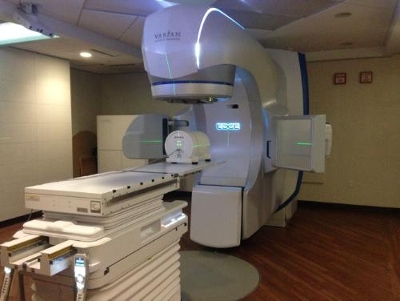 The Innovative Cancer Institute, Miami, has installed a new Edge radiosurgery system, a Varian Medical Systems platform offering doctors a quick, precise, non-invasive alternative to conventional surgery. This platform has already been used to treat a 71-year old patient who suffered from a large tumor invading his spinal cord.
The Innovative Cancer Institute, Miami, has installed a new Edge radiosurgery system, a Varian Medical Systems platform offering doctors a quick, precise, non-invasive alternative to conventional surgery. This platform has already been used to treat a 71-year old patient who suffered from a large tumor invading his spinal cord.
“The Edge system is ideal for this kind of case. It enables us to deliver high doses very precisely, with extra protection for adjacent critical structures,” Beatriz Amendola, MD, medical director at Innovative, said in a Varian press release. “We were able to confidently treat the tumor, which was beginning to impinge on the patient’s spinal cord, and get the patient back to normal life after just one treatment session. Without treatment, the spinal compression would have worsened, and most likely progressed to paralysis. Prior to the development of technology for spine radiosurgery, inoperable patients were left without any options other than to manage severe and chronic pain with narcotic analgesia.”
Radiosurgery is a type of radiation therapy where high doses of radiation can be delivered with a precise beam, in one to five treatment sessions.
Innovative is amongst the five sites in the U.S. to treat patients using the new Edge system, a platform that uses precisely shaped high-energy X-ray beams. With this technology, there is no need to preform incisions on the patient, resulting in minimal healing pain and recovery issues, when compared to normal surgery. Furthermore, this system includes Varian’s advanced medical linear accelerator and tools that allow real-time imaging, tumor tracking, motion management, and patient positioning.
[adrotate group=”1″]
“The Edge system enables us to treat multiple metastases at the same time, sometimes in a single treatment session rather than one-by-one, which is required when using some other radiosurgery systems,” Dr. Amendola explained in the press release. “That capability gives the Edge system a tremendous efficiency advantage when treating a patient with more than one tumor. We’re excited to be among the earliest adopters of this exciting new technology,” she added. “Our plan is to use it to expand our radiosurgery practice, starting with primary and metastatic spinal tumors, followed by skull base and other head and neck lesions. We will also use the system to treat lung cancer; metastatic tumors in places like the liver, lung, and adrenal gland; and radio-resistant tumors such as melanoma and renal cell cancer.”


